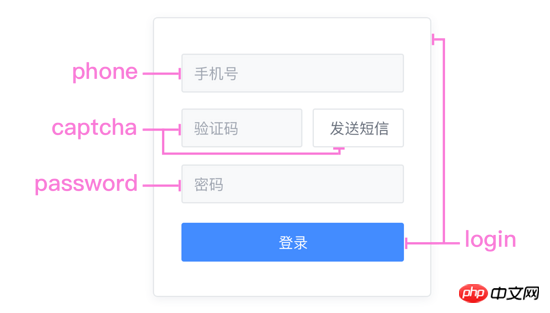Vue.js設定登入表單程式碼步驟剖析
- php中世界最好的语言原創
- 2018-05-11 14:59:101616瀏覽
這次帶給大家Vue.js設定登入表單程式碼步驟剖析,Vue.js設定登入表單程式碼的注意事項有哪些,下面就是實戰案例,一起來看一下。
業務場景
在之前,專案只支援手機號碼密碼登錄,前端是直接把表單寫死的,後來有客戶希望能支持驗證碼登錄,有的客戶還希望能有手機號驗證碼密碼的登入方式…所以登入方式的彈性需要可設定的表單支持,於是我把登入元件做了拆分。

以表單元素為粒度,分離出了手機號碼、密碼、簡訊驗證碼這幾個元件,它們內部都有自己的表單驗證方法,透過組合可以快速完成登入、註冊、找回密碼等表單元件。高內聚低耦合、高內聚低耦合…跟著念十遍~
. ├ common ├ captcha.vue | ├ password.vue | └ phone.vue ├ login | └ index.vue ├ register | └ index.vue └ resetPassword └ index.vue
這裡我們將login作為父元件,讀取服務端返回的登入配置並在模板做條件渲染,登入時調用子元件內部的表單驗證,最後透過Vuex拿到資料呼叫介面。整個可設定登入表單的邏輯就是醬子,接下來上程式碼。
程式碼
請求服務端設定資料:
/* 参数说明:
* 'password': 密码登录
* 'captcha': 短信验证码登录
* 'password_or_captcha': 密码或短信登录
* 'password_with_captcha': 密码+短信登录
*/
config: {
login_methods: 'password'
}
登入元件的核心渲染程式碼(pug):
.login-card .login-header h3 登录 .login-content phone(ref="phone") password( v-if="isPasswordMode" ref="password" ) captcha( v-if="isCaptchaMode" ref="captcha" ) template(v-if="isPasswordWithCaptchaMode") captcha(ref="captcha") password(ref="password") template(v-if="isPasswordOrCaptchaMode") ... el-button(@click="login") 登录
登入時需要三個步驟:表單驗證、組裝資料、呼叫介面:
async login () {
if (!this.validate()) return
const loginData = this.getLoginData()
await this.postLogin(loginData)
...
}
登入的表單驗證其實是對目前登入方式中所有元件的validate() 方法進行邏輯判斷:
validate () {
const phone = this.$refs.phone.validate()
let isPass = false
if (this.isPasswordMode) {
if (this.$refs.password) isPass = this.$refs.password.validate()
}
if (this.isCaptchaMode) {
if (this.$refs.captcha) isPass = this.$refs.captcha.validate()
}
if (this.isPasswordWithCaptchaMode) ...
if (this.isPasswordOrCaptchaMode) ...
isPass = phone && isPass
return isPass
}
每個子元件都是完整的表單,驗證也由自己完成,password元件範本:
.login-password el-form( :model="form" :rules="rules" ref="form" @submit.native.prevent="" ) el-form-item(prop="password") el-input( v-model="form.password" type="password" name="password" )
W3C: When there is only one single-line text input field in a form, the user agent should accept Enter in that field as a request to submit the form.
需要注意,根據W3C標準, 當一個form元素中只有一個輸入框時,在該輸入框中按下回車會自動提交表單。透過在
password元件的表單驗證:
validate () {
let res = false
this.$refs.form.validate((valid) => {
res = valid
})
return res
}
最後從Vuex拿到所有表單數據,進行組裝:
computed: {
...mapState('login', {
phone: state => state.phone,
password: state => state.password,
captcha: state => state.captcha
}),
},
methods: {
...
getLoginData () {
let mode = ''
const phone = this.phone
...
const data = { phone }
if (this.isPasswordMode) {
mode = 'password'
data.password = password
}
if (this.isCaptchaMode) {
mode = 'captcha'
data.captcha = captcha
}
if (this.isPasswordWithCaptchaMode) ...
if (this.isPasswordOrCaptchaMode) ...
data.mode = mode
return data
}
}
補充:
vue.js 全選與取消全選的實例代碼
new Vue({
el: '#app',
data: {
checked: false,
checkedNames: [],
checkedArr: ["Runoob", "Taobao", "Google"]
},
methods: {
changeAllChecked: function() {
if (this.checked) {
this.checkedNames = this.checkedArr
} else {
this.checkedNames = []
}
}
},
watch: {
"checkedNames": function() {
if (this.checkedNames.length == this.checkedArr.length) {
this.checked = true
} else {
this.checked = false
}
}
}
})
#相信看了本文案例你已經掌握了方法,更多精彩請關注php中文網其它相關文章!
推薦閱讀:
以上是Vue.js設定登入表單程式碼步驟剖析的詳細內容。更多資訊請關注PHP中文網其他相關文章!

